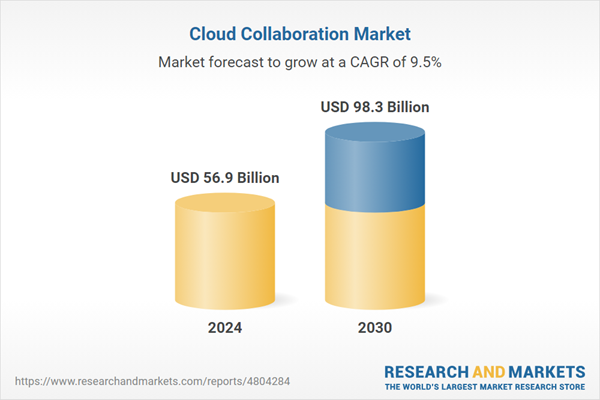The global market for Cloud Collaboration was valued at US$56.9 Billion in 2024 and is projected to reach US$98.3 Billion by 2030, growing at a CAGR of 9.5% from 2024 to 2030. This comprehensive report provides an in-depth analysis of market trends, drivers, and forecasts, helping you make informed business decisions. The report includes the most recent global tariff developments and how they impact the Cloud Collaboration market.
Segments: Segment (Unified Communication & Collaboration, Document Management System, Project & Team Management, Enterprise Social Collaboration).
Geographic Regions/Countries: World; United States; Canada; Japan; China; Europe (France; Germany; Italy; United Kingdom; and Rest of Europe); Asia-Pacific; Rest of World.
The analysts continuously track trade developments worldwide, drawing insights from leading global economists and over 200 industry and policy institutions, including think tanks, trade organizations, and national economic advisory bodies. This intelligence is integrated into forecasting models to provide timely, data-driven analysis of emerging risks and opportunities.
Global Cloud Collaboration Market - Key Trends and Drivers Summarized
Why Is Cloud Collaboration Transforming How Teams Work?
Cloud collaboration has emerged as a transformative force in the modern workplace, fundamentally changing how teams communicate, share information, and work together. Unlike traditional collaboration methods, cloud collaboration allows team members to access shared files, documents, and communication platforms from anywhere with an internet connection, making it easier for geographically dispersed teams to work in real-time. This capability is especially critical in the wake of the global shift toward remote and hybrid work environments, where physical proximity is no longer a prerequisite for teamwork. Cloud collaboration tools, such as Google Workspace, Microsoft Teams, and Slack, have made it possible to centralize workflows, enabling employees to collaborate on projects, co-edit documents, and engage in video conferencing without the need for complex IT infrastructure. The increased accessibility and flexibility of cloud collaboration platforms are driving businesses toward a more efficient and integrated way of working, where knowledge and resources can be shared instantly across teams, departments, and even time zones.How Are Technological Innovations Driving Cloud Collaboration to the Next Level?
Technological advancements have significantly elevated the capabilities of cloud collaboration platforms, making them more robust, secure, and user-friendly. One of the most significant drivers of innovation in this space is the integration of artificial intelligence (AI) and machine learning (ML). AI-driven features such as automated task assignments, smart scheduling, and real-time translation are enhancing the efficiency of cloud collaboration tools, enabling teams to work faster and with fewer errors. Additionally, improvements in video conferencing technology, supported by 5G and edge computing, have improved the quality and reliability of virtual meetings, making remote collaboration as seamless as in-person interactions. Another critical innovation is the integration of cloud collaboration tools with other enterprise applications, such as customer relationship management (CRM) systems, project management software, and data analytics platforms, enabling teams to work within a unified ecosystem. Security advancements, including end-to-end encryption and multi-factor authentication, are also ensuring that cloud collaboration remains secure, even as more sensitive and high-stakes information is shared across platforms. These technological breakthroughs are enabling businesses to fully leverage the potential of cloud collaboration, transforming how work gets done in a digital-first world.Where Are Cloud Collaboration Platforms Making the Biggest Impact?
Cloud collaboration platforms are making a significant impact across a wide array of industries, revolutionizing the way businesses operate and interact both internally and externally. In the education sector, for instance, cloud collaboration tools are being used to support online learning environments, where students and teachers can share resources, attend virtual classes, and collaborate on projects in real-time. This shift has been particularly vital during the COVID-19 pandemic, where distance learning became the norm. In the healthcare sector, cloud collaboration is transforming how medical teams coordinate patient care, with tools enabling real-time sharing of medical records, consultation notes, and diagnostic images across different healthcare providers and facilities. In the corporate world, businesses are using cloud collaboration platforms to streamline operations, particularly in sectors such as technology, finance, and professional services, where cross-departmental and cross-border collaboration is essential. Cloud collaboration also plays a crucial role in creative industries like media and design, where multiple stakeholders often need to work on content simultaneously, share feedback, and make real-time changes. Across these industries, cloud collaboration tools are breaking down silos, improving productivity, and fostering innovation through enhanced teamwork.What Are the Key Growth Drivers in the Cloud Collaboration Market?
The growth in the cloud collaboration market is driven by several factors, with one of the primary drivers being the increasing shift toward remote and hybrid work models. As businesses adapt to a workforce that is no longer confined to the office, the need for flexible, scalable, and accessible collaboration tools has grown exponentially. The demand for seamless communication, real-time file sharing, and integrated project management capabilities is pushing organizations to adopt cloud-based solutions that enable efficient collaboration across locations and time zones. Additionally, the growing use of mobile devices and the proliferation of high-speed internet connections are making it easier for teams to stay connected and productive from any location, further fueling the adoption of cloud collaboration platforms. Another key driver is the increasing need for cross-functional collaboration as businesses move toward more decentralized and agile work structures. Cloud collaboration tools, which integrate with other enterprise systems, help break down departmental silos and enable teams to work together more effectively. Security is also a significant driver, as businesses seek platforms that provide secure, compliant communication channels, particularly in industries like finance, healthcare, and legal services where sensitive data is shared regularly. Lastly, the continuous innovation in AI and machine learning within these platforms is creating more intuitive and automated collaboration experiences, allowing teams to focus on high-value tasks while the technology handles administrative functions. These factors collectively are accelerating the growth of the cloud collaboration market as organizations of all sizes seek to enhance their productivity, agility, and connectivity in an increasingly digital world.Report Scope
The report analyzes the Cloud Collaboration market, presented in terms of units. The analysis covers the key segments and geographic regions outlined below.Segments: Segment (Unified Communication & Collaboration, Document Management System, Project & Team Management, Enterprise Social Collaboration).
Geographic Regions/Countries: World; United States; Canada; Japan; China; Europe (France; Germany; Italy; United Kingdom; and Rest of Europe); Asia-Pacific; Rest of World.
Key Insights:
- Market Growth: Understand the significant growth trajectory of the Unified Communication & Collaboration segment, which is expected to reach US$51.8 Billion by 2030 with a CAGR of a 10.2%. The Document Management System segment is also set to grow at 8.1% CAGR over the analysis period.
- Regional Analysis: Gain insights into the U.S. market, valued at $15.5 Billion in 2024, and China, forecasted to grow at an impressive 8.9% CAGR to reach $15.2 Billion by 2030. Discover growth trends in other key regions, including Japan, Canada, Germany, and the Asia-Pacific.
Why You Should Buy This Report:
- Detailed Market Analysis: Access a thorough analysis of the Global Cloud Collaboration Market, covering all major geographic regions and market segments.
- Competitive Insights: Get an overview of the competitive landscape, including the market presence of major players across different geographies.
- Future Trends and Drivers: Understand the key trends and drivers shaping the future of the Global Cloud Collaboration Market.
- Actionable Insights: Benefit from actionable insights that can help you identify new revenue opportunities and make strategic business decisions.
Key Questions Answered:
- How is the Global Cloud Collaboration Market expected to evolve by 2030?
- What are the main drivers and restraints affecting the market?
- Which market segments will grow the most over the forecast period?
- How will market shares for different regions and segments change by 2030?
- Who are the leading players in the market, and what are their prospects?
Report Features:
- Comprehensive Market Data: Independent analysis of annual sales and market forecasts in US$ Million from 2024 to 2030.
- In-Depth Regional Analysis: Detailed insights into key markets, including the U.S., China, Japan, Canada, Europe, Asia-Pacific, Latin America, Middle East, and Africa.
- Company Profiles: Coverage of players such as Cisco Systems, Inc., Google LLC, Intralinks Holdings, Inc., Jive Software, Inc., Microsoft Corporation and more.
- Complimentary Updates: Receive free report updates for one year to keep you informed of the latest market developments.
Some of the 78 companies featured in this Cloud Collaboration market report include:
- Cisco Systems, Inc.
- Google LLC
- Intralinks Holdings, Inc.
- Jive Software, Inc.
- Microsoft Corporation
- Mitel Networks Corporation
- Oracle Corporation
- Salesforce.com, Inc.
Tariff Impact Analysis: Key Insights for 2025
Global tariff negotiations across 180+ countries are reshaping supply chains, costs, and competitiveness. This report reflects the latest developments as of April 2025 and incorporates forward-looking insights into the market outlook.The analysts continuously track trade developments worldwide, drawing insights from leading global economists and over 200 industry and policy institutions, including think tanks, trade organizations, and national economic advisory bodies. This intelligence is integrated into forecasting models to provide timely, data-driven analysis of emerging risks and opportunities.
What’s Included in This Edition:
- Tariff-adjusted market forecasts by region and segment
- Analysis of cost and supply chain implications by sourcing and trade exposure
- Strategic insights into geographic shifts
Buyers receive a free July 2025 update with:
- Finalized tariff impacts and new trade agreement effects
- Updated projections reflecting global sourcing and cost shifts
- Expanded country-specific coverage across the industry
Table of Contents
I. METHODOLOGYII. EXECUTIVE SUMMARY2. FOCUS ON SELECT PLAYERSIII. MARKET ANALYSISIV. COMPETITION
1. MARKET OVERVIEW
3. MARKET TRENDS & DRIVERS
4. GLOBAL MARKET PERSPECTIVE
UNITED STATES
CANADA
JAPAN
CHINA
EUROPE
FRANCE
GERMANY
ITALY
UNITED KINGDOM
REST OF EUROPE
ASIA-PACIFIC
REST OF WORLD
Companies Mentioned (Partial List)
A selection of companies mentioned in this report includes, but is not limited to:
- Cisco Systems, Inc.
- Google LLC
- Intralinks Holdings, Inc.
- Jive Software, Inc.
- Microsoft Corporation
- Mitel Networks Corporation
- Oracle Corporation
- Salesforce.com, Inc.
Table Information
| Report Attribute | Details |
|---|---|
| No. of Pages | 212 |
| Published | April 2025 |
| Forecast Period | 2024 - 2030 |
| Estimated Market Value ( USD | $ 56.9 Billion |
| Forecasted Market Value ( USD | $ 98.3 Billion |
| Compound Annual Growth Rate | 9.5% |
| Regions Covered | Global |









